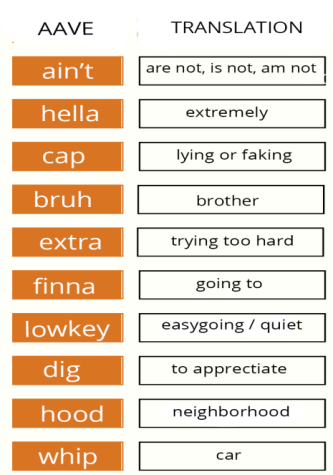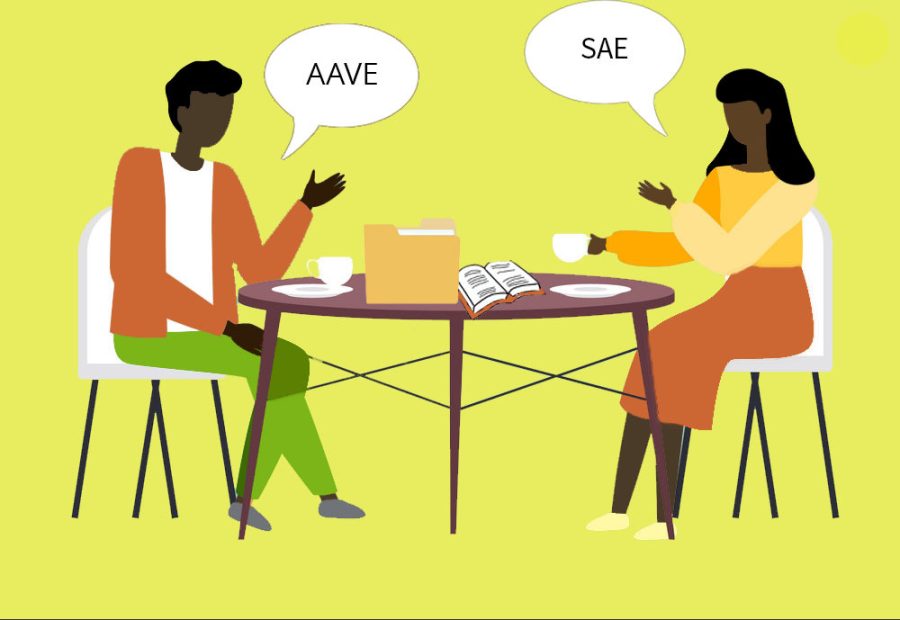AAVE’s rich culture, development and history
October 10, 2022
Terms like “lowkey,” “hella” and “cap” may seem like a recent development in trendy language, but they all have their roots in African American Vernacular English, a dialect primarily spoken by the Black community. AAVE phrases have subconsciously permeated into many people’s everyday terminology. Social media widely represents AAVE, often portraying it as informal slang without sharing its rich origin or history.
AAVE, also known as ebonics or African American English, originated in Southern slave plantations. Denied the right to education, slaves took it upon themselves to learn English. After overhearing and interpreting the language slave owners engaged in, Black people developed AAVE.
In post-Civil War America, Black communities were usually isolated in smaller parts of cities, known as ghettos, due to continual racial prejudice and segregation. With this consolidation of Black residents, the AAVE dialect was preserved and has lasted to today, as the dialect continues to grow and adapt.
“AAVE is a way of life where we are preserving, remembering and acknowledging the pain and struggle our ancestors went through in order to give us what we have today,” senior and co-president of Cupertino High School’s Black Student Union Liza Thorpe said.
Many misconceptions surround AAVE and its purpose. For instance, many people view it as a form of slang, while others view it as an incorrect form of English. The reality is that AAVE is a language of its own with a historically rich and complex development.
 There are many stylistic features in AAVE that differ from Standard American English. A common characteristic is Verbal Copula, in which phrases or sentences leave out the words “is” and “are.” Some examples include the phrases “she does not say where she going” or “they smart.” The use of double negatives is also common; the phrase “he ain’t never” is the equivalent of “he has not” in SAE. Certain words or phrases have unique meanings that pertain to AAVE but not SAE. In AAVE, for instance, the word “dig” means to understand or appreciate, and the word ”paper” means money. Speakers of AAVE also use the word “do” to indicate an ongoing or habitual action.
There are many stylistic features in AAVE that differ from Standard American English. A common characteristic is Verbal Copula, in which phrases or sentences leave out the words “is” and “are.” Some examples include the phrases “she does not say where she going” or “they smart.” The use of double negatives is also common; the phrase “he ain’t never” is the equivalent of “he has not” in SAE. Certain words or phrases have unique meanings that pertain to AAVE but not SAE. In AAVE, for instance, the word “dig” means to understand or appreciate, and the word ”paper” means money. Speakers of AAVE also use the word “do” to indicate an ongoing or habitual action.
In modern day, AAVE has widely influenced the way teens speak, though many interpret phrases taken from AAVE as Gen Z slang. Many AAVE words that have become mainstream such as “bruh,” “cap” and “dope” are used by non-black teens as well. As a result, teens across the US are using this vernacular while remaining unaware of its origin. Non-black celebrities using AAVE have sparked controversy among the American community. For instance, Billie Elish, a mainstream white pop singer, was recently accused of using blaccent, a term used to describe a fake black accent used as cultural appropriation, and faced backlash from her fans.
“When AAVE is co-opted and used by other groups, in particular, corporations, influencers and people outside the community, it definitely can teeter on appropriation and cultural insensitivity,” Dr. Julie Keiffer-Lewis, department chair of African American Studies at De Anza College said.
Contrary to its vast use in social media vernacular, AAVE in the workplace is often regarded as informal and implies the person is uneducated, creating a linguistic prejudice — a bias formed on how someone speaks. Oftentimes, Black people and other people of color change the way they speak depending on who their audience is, known as code-switching. This switch is meant to prevent linguistic prejudice, as it makes the person seem more fluent and comfortable in English. These behavioral changes are more frequent in less diverse or white-dominated groups, like most corporate workplaces.
“White people have set the tone and the guidelines for how society is supposed to run, and sometimes we subconsciously abide by those rules,” Thorpe said.
Increased inclusivity across races in TV, movies and plays, including colorblind casting, a practice in which race is not a determining factor in choosing actors and actresses for roles, has also grown more prevalent. Lin Manuel Miranda’s Hamilton, the Broadway musical based on Alexander Hamilton’s life, practices colorblind casting and has led to a lot of support from people of color who feel their voices are being amplified. However, it has also incurred backlash from those who argue that the use of AAVE when portraying white characters is “inauthentic” or does not convey the full historical story.
In 1996, The Oakland School District recognized AAVE as a dialect, meant to destigmatize AAVE and bring more attention to its cultural and historical significance. This step was the first of its kind to acknowledge AAVE but received backlash, with some arguing that AAVE’s recognition in schools may lower the quality of education.
There continues to be widespread ignorance of the differences between modern slang and AAVE as social media becomes increasingly prevalent. Regardless, people are becoming more mindful of the vernacular and its origination on plantations centuries ago.
“AAVE is part of our community not only as a language of pain but also a language of overcoming trials and tribulations. We were forced into this impossible situation for centuries and still to this day, we prevail,” Thorpe said.





































































Anna • May 25, 2024 at 12:18 pm
amazing article that summarizes this variety well to get me started on my research! thank you